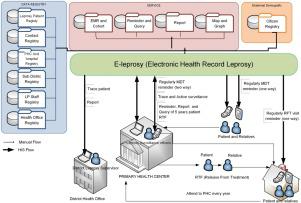International Journal of Medical Informatics ( IF 3.7 ) Pub Date : 2020-05-11 , DOI: 10.1016/j.ijmedinf.2020.104155 Enny Rachmani,Ming-Chin Lin,Chien Yeh Hsu,Jumanto Jumanto,Usman Iqbal,Guruh Fajar Shidik,Edi Noersasongko

|
Background and Objective
The implementation of health information systems (HIS) could overcome obstacles in human resources and infrastructure at primary health care centers (PHCs). This study involved an e-Leprosy framework being integrated into the real setting of a leprosy control program in Indonesia. The objectives of this implementation study were to integrate e-Leprosy into a leprosy control program at 27 PHCs in Pekalongan District. Central Java Province, Indonesia to explore factors related the success or failure of such an implementation regarding the usability, involvement, and acceptance of e-Leprosy by PHC staff and to evaluate the effect of the implementation on leprosy patient attendance at PHCs. This paper is based on the Standards for Reporting Implementation Studies (StaRI) statement.
Method
This study used mixed methods implementation research with longitudinal analysis and involved two groups of participants: Leprosy Surveillance Officers (LSOs), patients, and the relatives of patients. This study involved four phases consisting of preparation, baseline assessment, intervention, and evaluation. The qualitative study conducted focus group discussions and in-depth interviews. The e-Leprosy program automatically sent SMS reminders regarding leprosy treatment to the LSOs, patients, and patients’ relatives every month.
Findings
This study determined that LSO had difficulties related to their workloads in PHCs while managing information and monitoring treatment and contact after release from treatment. The baseline assessment phase found that LSOs in Pekalongan District were unfamiliar with email but familiar using the internet. Overall, LSOs had a positive perception of the e-Leprosy program. The usability of this e-Leprosy program tended to increase over time, while acceptance of the e-Leprosy exhibited a significant relationship with computer and internet fluency (r = 0.48, p < 0.05) and age (r = 0.621, p < 0.01). The responsible patients correlated (r = 0.67, p < 0.01) with involvement in the e-Leprosy program. This study revealed that patient reminders increased on-time attendance by 13.9 % (p < 0.01 with OR = 2.41).
Conclusion
Factors that should be considered during implementation HIS included the digital gap, PHC’s staff workload, as well as the level of commitment and leadership in the health office.
中文翻译:

印度尼西亚初级卫生保健中心在麻风控制计划中实施了电子麻风综合框架。
背景与目的
卫生信息系统(HIS)的实施可以克服初级卫生保健中心(PHC)在人力资源和基础设施方面的障碍。这项研究涉及将电子麻风框架整合到印度尼西亚的麻风控制计划的实际环境中。这项实施研究的目标是将电子麻风病纳入北加隆安区27个初级卫生保健中心的麻风病控制计划。印度尼西亚中爪哇省,将探讨与实施这种方法的成败有关的因素,这些因素涉及PHC工作人员对电子麻风病的可用性,参与度和接受程度,并评估该实施对麻风病患者在PHC出勤的影响。本文基于报告实施研究标准(StaRI)声明。
方法
这项研究使用了混合方法实施研究和纵向分析,涉及两组参与者:麻风监护官员(LSO),患者和患者的亲属。这项研究涉及四个阶段,包括准备,基线评估,干预和评估。定性研究进行了焦点小组讨论和深入访谈。电子麻风病程序每月自动向LSO,患者和患者的亲属发送有关麻风病治疗的SMS提醒。
发现
这项研究确定,LSO在管理信息以及监测治疗和释放后的联系方面存在困难,与他们在PHC中的工作量有关。基线评估阶段发现,北加隆安区的LSO不熟悉电子邮件,但熟悉使用互联网。总体而言,民间社会组织对电子麻风计划抱有积极的看法。随着时间的流逝,该电子麻风病项目的可用性趋于增加,而对电子麻风病项目的接受程度则与计算机和互联网的流畅程度(r = 0.48,p <0.05)和年龄(r = 0.621,p <0.01)有着显着的关系。 。负责任的患者与电子麻风病项目相关(r = 0.67,p <0.01)。这项研究表明,患者提醒可以增加按时出勤率13.9%(p = 0.01,OR = 2.41)。
结论
在实施HIS时应考虑的因素包括数字鸿沟,PHC的员工工作量以及卫生办公室的承诺和领导水平。











































 京公网安备 11010802027423号
京公网安备 11010802027423号